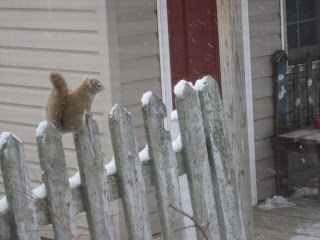When you think of northern Wisconsin, you don't think of lions and tigers. Yet, about 15 miles from our farm we had these wild beasts. Behn's Game Farm in Aniwa, WI, was an unbelievable place to go as a child - even an adult! Mr. Behn's was a true performer, eating fire, taming lions and tigers, always a showman. Driving down Hwy 52 nestled behind the pine trees, was this little circus treasure. I had been there many times as a child. Schools would go on field trips there. Mr. & Mrs. Behns were like your grandma and grandpa.
They also hosted a small annual animal swap, where kids, 4-Hrs even locals would set up their cages in his parking lot and swap or buy from others looking for a pet or project animal. Justine got her first rabbit, "Misty Bunny", from a swap held there. In fact, one of the main reasons I wanted goats was because of the goats they had at Behn's. His silly goats use to climb a ramp to a stand, you would put corn in a bucket and the goats would pull the rope up to the stand and eat it. This was really cute. Little did I know goats didn't just come that way. I loved my goats, however they were not that smart!
My grandpa Kincaid, who worked in the woods near Crandon, gave Mr. Behn a bear cub. My grandpa came across this little orphaned cub (mother hit by car) and knew just the place to take it where it would be properly cared for. Behn's Game farm. Mr. Behn did train this cub to perform and later rumor had it that it performed in TV shows - someone once said Gentle Ben....but that can't be right because this was a black bear. However, he did train the bear cub.
Mr. Behn passed away this week - he had a colorful life! Oh that we all could find the lions and tigers in our life and tame them the way he did! Thanks for the memories.
| Wild Kingdom >> Wisconsin Cat ManWith a little Aquanet and a lot of bronzer, he could step in for Siegfried and Roy.© Rake Publishing, Inc. November 2003 “Wilbert! Wilbert!” his wife yelled at the top of her lungs toward the makeshift house behind the llama cage at Behn’s Game Farm in the tiny town of Aniwa, in northern Wisconsin. “He’s hard of hearing,” she explained. With a slight limp, Wilbert slowly emerged from the plywood building, looking as though he’d just awakened from a nap. At eighty years old and some change, Wilbert Behn is the oldest lion and tiger tamer in the world. His white hair is frazzled, perhaps from his snooze, and his ratty jeans and soiled shirt carry a ripe smell that suggests he knows animals. As he walked by the tiger cage, the fierce Bengali and Siberian cats watched him nervously. Obviously, they know who’s the boss. How does one become a lion tamer? “One day I just jumped in the ring and tried it out,” Wilbert remembered. “I’ve been doing shows ever since, for the last forty-nine years. You should try it—you never know if you’re a natural until you get in the cage,” he told me. I couldn’t tell if he was joking. I did not point out that if I find out I’m not a natural, I’ll be dead. I asked the missus what they usually feed these big cats, who seemed to be eyeing me hungrily. “Oh, fresh meat. Usually beef or veal. We don’t get as many horses anymore because people sell them for dog food.” Wilbert said that feeding time can be dangerous, though. “Once when I was feeding the lion, I got bit through both of my legs, and I got clobbered. I stepped over the trough and he just figured I was meat. I was real hung up for a while, until someone came to help me. If it wasn’t for rubber boots, I wouldn’t be around anymore.” Nevertheless, Wilbert retains his cool composure around the cats. “I always look them in the eye. If you don’t, that’s when they get you. I use two objects, since the cats can’t concentrate on two things at a time. You know if I really didn’t want to get hurt by the cats, though, the only thing I could really do would be to stay the heck out of the ring.” The danger isn’t only to the tamer, however. “I’ve had up to six cats in the ring at the same time, and once I did a show and the lioness went after the tiger. She bit the tiger right through the shoulder blade and blood was everywhere. I finally was able to get them separated by distracting them, so they didn’t kill each other. I looked into the stands and noticed that the audience had run away.” “See, most cats are declawed to make them less dangerous, but I never declaw or neuter them. If they’re neutered or declawed, I wouldn’t even have them on a plate—they’re still dangerous. A woman just got maimed down in Busch Gardens, Florida. A cat got her and chewed off her arm at the elbow.” Wilbert seems to love the danger of training lions and tigers, however, and he lifted up his shirt to show me scars from tiger bites across his body. But many tamers aren’t even that lucky. Wilbert told the gruesome story of his friend Dwayne who started another circus in northern Wisconsin. “The first show he did, a cat got a hold of him. The lion dragged him around the ring in front of two hundred schoolkids and their parents. He was dead by then, though.” Wilbert shakes his head sadly. “Now, every time I do a show, I can still see him standing there in the ring with me.” Wilbert viewed this incident as a reason to continue with his work. He pointed out his plywood auditorium with the large sign above the door that says, “NOT RESPONSIBLE FOR INJURIES.” Ever the showman, Wilbert said, “If you want, I could bring the cats into the ring and give you a show now!”—Eric Dregni |































